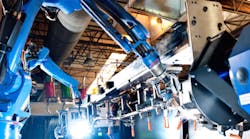How to Prepare Your Workforce for Smart Manufacturing
The shop floor is rapidly changing as it evolves from a place bound by hands-on labor and interpersonal communication skills to an environment of smart machines that collect and analyze data, captured in real-time, to provide valuable insights into the manufacturing process. Meanwhile, the skills gap widens as advanced manufacturing firms struggle to find and train workers with the skills they need to keep pace with the technological-industrial revolution.
In order for our workforce to be a conduit rather than a barrier to the productivity improvements promised by Smart Manufacturing, we must take action without delay.
Disruptive Innovation
The discussion pertaining to adoption and utilization of connected machinery and analytics capabilities as a means to turn data into real business value has recently gained more popularity. However, even in the midst of such popularity, there has been been little discussion on how best to mitigate the workforce skills gap generated by a more connected manufacturing ecosystem. To be sure, addressing the workforce skills gap issue must be a top priority among any firm seeking to adopt IIoT and Smart Manufacturing into its business model. According to recent research conducted by Deloitte in partnership with The Manufacturing Institute, an estimated 2.7 million jobs are likely to be needed as a result of retirements of the existing workforce in advanced manufacturing, while 700,000 jobs are likely to be created due to natural business growth. Overall this creates a gap of 3.4 million jobs, with more than 60% of the gap directly tied to a talent shortage or skills mismatch.
Furthermore, in a recent report by Accenture, 88% of manufacturing executives polled stated they are unprepared for the coming disruption to current operating models as a result of IIoT. Eighty-four percent also stated that their workforce is not ready for the adoption of IIoT. This added layer to the traditional skills gap—what I call the Industrial Internet of Things (IIoT) Skills Gap—will almost certainly widen with the continued integration of smart data within the advanced manufacturing sector as technological production outstrips human-based production.
Building a Path Forward
What can be done to mitigate the IIoT Skills Gap? The key to moving forward will be to develop and cultivate a path of collaboration among advanced manufacturing and technical education leaders. Advanced manufacturers of all shapes and sizes, if they wish to fully integrate the use of network and Internet connectivity as a means to employ the full benefit of data and analytics, will need to consider the following when it comes to addressing IIoT Skills Gap:
Collaboration among Industry and Career and Technical Education Providers
Smart manufacturers must immediately begin to lead and collaborate with career and technical education providers as a means to ensure what is being taught in the classroom and lab translate to the skills necessary to operate in smart manufacturing firms. Many career and technical education providers within secondary and post-secondary education will face resource, capacity and expertise limitations that will only further widen the IIoT Skills Gap. Experts from the advanced manufacturing sector must play an integral role in the development of training programs, identification of software and machinery and resources required to best prepare workers for employment within smart manufacturing firms. Harnessing the expertise and resources of both educators and manufacturing leaders is key to addressing the IIoT Skills Gap.
Collaboration among IT, Training, HR, Safety and Operations Managers
Smart manufacturing requires the involvement and integration of numerous stakeholders. In addition to educators and manufacturing leaders, smart manufacturers must engage with staff members of IT, human resources, quality assurance, operations, training, and safety departments as a means to ensure all members of the smart manufacturing team are engaged and working closely together towards a common goal. For instance, engineering teams will need to ensure they have communicated plans for the installment of a new production line with IT staff, who will in turn be responsible for developing the data network while simultaneously providing maintenance technicians with the necessary software and analytics tools required to diagnose and troubleshoot problems on the new production line. A complete integration of the advanced manufacturing ecosystem will indeed revolutionize the manufacturing firm at all levels and across all value streams. No longer will siloed departments be able to get by without communicating with colleagues on other teams within the plant. Full integrations of systems and machinery also means full integration of departments, staffs, and work plans.
Promote Awareness of Smart Manufacturing
Those working, those seeking work, and members of the public in general should at every opportunity be made aware of the opportunities and innovation created by IIoT and smart manufacturing. To be sure, the manufacturing sector currently struggles to shift public perception in regard to the benefits of a career in manufacturing. Taking hold of a movement of youth education programs related to STEM and sharing the news about the innovations in manufacturing can play a key role in supporting the recruitment and retention of a strong pool of workers in the smart manufacturing sector. The rebirth of manufacturing should be celebrated and integrated into our culture as a means to shift the traditional perspective that a blue-collar career path is anything but first-class.
Time for Action
Smart manufacturing firms must go great lengths to prepare their workforce for the new age of technological-industrial revolution. IIoT and smart manufacturing will require that workers configure, maintain, operate and repair smart machines and robots as part of the manufacturing processes. The roles of stacking, packing, picking and racking will give way to roles that require a deep understanding of digital diagnostics and analysis. Investments must be made, training programs must be developed and stories must be told about the brilliance of the current transformation within the advanced manufacturing sector. The time is now for smart manufacturers to take the lead and work with education partners to ensure tomorrow’s workforce is fully equipped make advanced manufacturing more efficient, sustainable and innovative.
Mardy Leathers is the Executive Director for the Center for Workforce Development at East Central College in Union, Mo.




